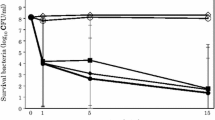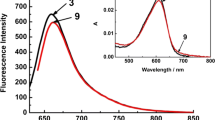Summary
Crystal violet from Gram stained S. aureus can be extracted completely by 95% ethanol if the stained bacteria is pre-treated with dilute sodium thiosulphate solution. Thiosulphate removes iodine form the cell component-dye-iodine complex instantaneously and renders the dye extractable by the differentiating medium. 1∶1 alcoholic solutions of aniline, dimethyl aniline, nitro-benzene, benzene, toluene or xylol can also extract the color from the stained S. aureus; the extraction with the first three solvents is almost exhaustive while with the latter solvents extraction is appreciable but incomplete. These solvents can form charge-transfer complexes with iodine. The findings indicate that the stability of the cell component-dye-iodine complex determines the Gram-character of the cell. A model hasbeen presented for the Gram cell component-dye-iodine complex.
Similar content being viewed by others
References
Bartholomew, J. W., T. Cromwell, and H. Finkelstein: A correlation between iodine permeability and the gram characteristic of cells. Nature (Lond.) 183, 123–124 (1959).
—, and T. Mittwer: The gram stain. Bact. Rev. 16, 1–29 (1952).
Basu, P. S., B. B. Biswas, and M. K. Pal: Escherichia coli exhibiting gram positivity after cetyl pyridinium chloride treatment. Histochemie 10, 261–265 (1967).
Benians, T. H. C.: A further investigation into the principles underlying Gram's stain, with special reference to the bacterial cell membrane. J. Path. Bact. 23, 401–412 (1920).
Burke, V.: Notes on the gram stain with description of a new method. J. Bact. 7, 159–182 (1922).
—, and M. Barnes: The cell wall as a factor in the gram reaction. J. Bact. 15, 12 (1928).
—: The cell wall and the gram reaction. J. Bact. 18, 69–92 (1929).
Chandra, A. K., and D. C. Mukherjee: Molecular complexes of anilines with iodine and iodine monochloride. Trans. Faraday Soc. 60, part I, 62–71 (1964).
Gram, C.: Über die isolierte Färbung der Schizomyceten in Schnitt- und Trockenpräparaten. Fortschr. Med. 2, 185–189 (1884).
Hucker, G. J., and H. J. Conn: Further studies on the methods of gram staining. N.Y. (Geneva) Agr. Exp. Sta. Tech. Bull. 128, 1–34 (1927).
Jones, A. S., S. B. H. Rizvi, and M. Stacey: The phosphorus-containing compounds of gram-positive and gram-negative organisms in relation to the gram staining reaction. J. gen. Microbiol. 18, 597–606 (1958).
Kaplan, M. L., and L. Kaplan: The gram stain and differential staining. J. Bact. 25, 309–321 (1933).
Libenson, L., and A. P. McIlroy: On the mechanism of the gram stain. J. infect. Dis. 97, 22 (1955).
Mitchell, P., and J. Moyle: Occurrence of a phosphoric ester in certain bacteria: its relation to gram staining and penicillin sensitivity. Nature (Lond.) 166, 218–220 (1950).
Mittwer, T., J. W. Bartholomew, and B. J. Kallman: The mechanism of the gram reaction. II. The function of iodine in the gram stain. Stain Technol. 25, 169–179 (1950).
Mulliken, R. S.: Structures of complexes formed by halogen molecules with aromatic and with oxygenated solvents. J. Amer. chem. Soc. 72, 600–608 (1950).
Pal, M. K.: Effects of differently hydrophobic solvents on the aggregation of cationic dyes as measured by quenching of fluorescence and/or metachromasia of the dyes. Histochemie 5, 24–31 (1965).
—, and M. Schubert: Measurement of the stability of metachromatic compounds. J. Amer. chem. Soc. 84, 4384–4393 (1962).
Pearse, A. G. E.: Histochemistry, p. 217. London: J. & A. Churchill Ltd. 1960.
Rao, C. N. R.: Ultra-violet and visible spectroscopy, p. III-121. London: Butterworths 1961.
Salton, M. R. J.: The bacterial cell wall, p. 29–36. Amsterdam: Elsevier Publ. Co. 1964.
Shugar, D., and J. Baranowska: Gram staining of extracellular material. Biochim. biophys. Acta (Amst.) 23, 227–228 (1957).
Wensinck, F., and J. J. Boevé: Quantitative analysis of the gram reaction. J. gen. Microbiol. 17, 401–413 (1957).
Author information
Authors and Affiliations
Rights and permissions
About this article
Cite this article
Basu, P.S., Biswas, B.B. & Pal, M.K. Extraction of crystal violet-iodine complex from gram positive bacteria by different solvents and its implication on gram differentiation. Histochemie 14, 221–229 (1968). https://doi.org/10.1007/BF00306318
Received:
Issue Date:
DOI: https://doi.org/10.1007/BF00306318




